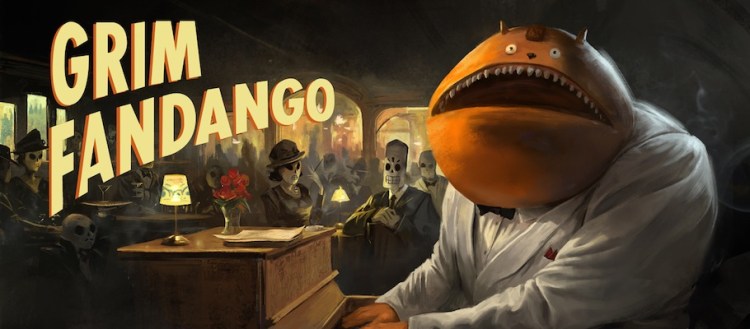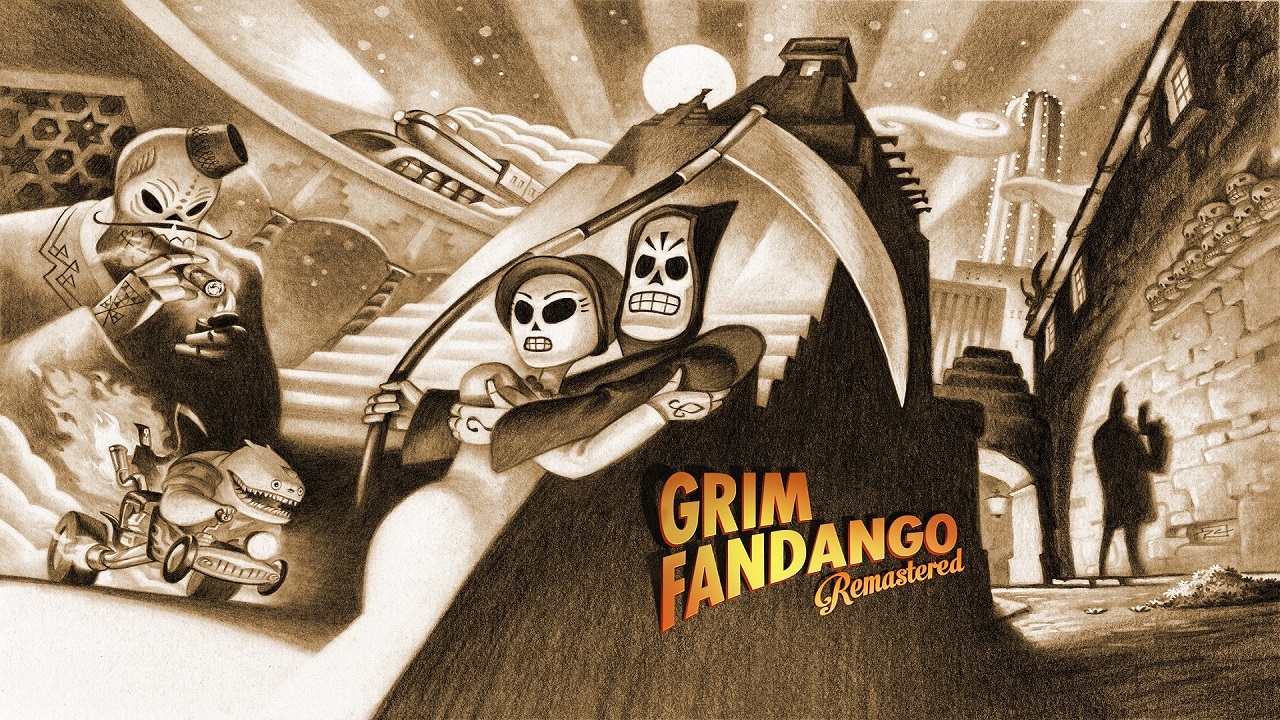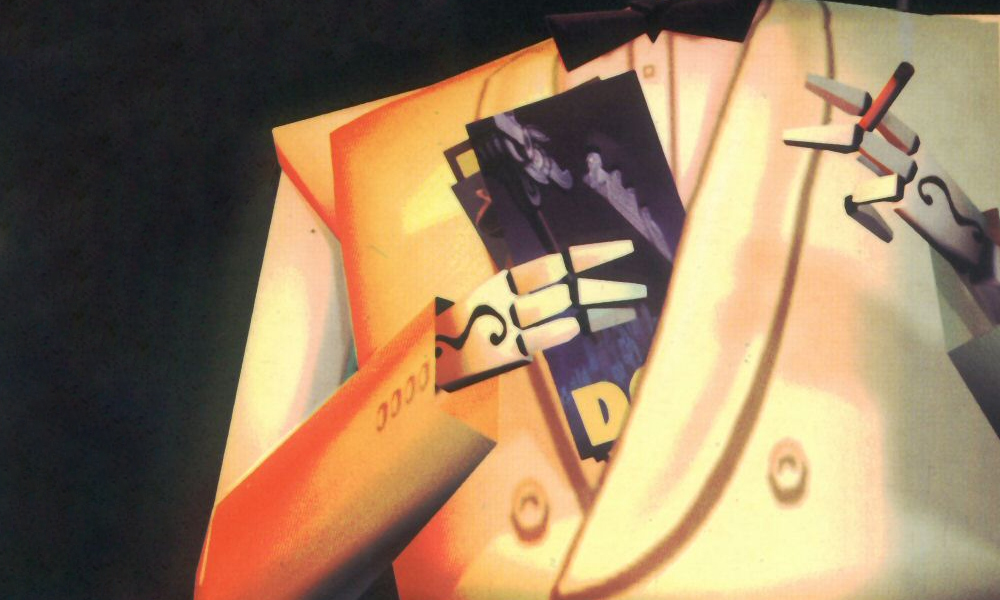GamesBeat: Take me back to working on the original Grim Fandango. When you were first approached with this idea, was it something that was hard to visualize at first?
McConnell: That would have been maybe early 1997, when I first started to work on it. Let me see if I can remember things right. I saw some concept art, I saw some sketches of Manny very early on and I was like, “Wow, what is this?” Grim came out at a time — it was very much a perfect storm of cultural stuff going on. Swing music was pretty hip at the time. Maybe just after Grim came out was when Big Bad Voodoo Daddy played the Super Bowl? There was this whole new swing movement that was happening somewhere around the time. It was very current in that sense.
I had been in a band around that time. The Mission District of San Francisco is where a lot of the clubs are, and in particular, there are a bunch that play jazz, that would play acid jazz or new swing, maybe right around the corner from a cantina. Basically, the entire Grim score — you could hear it walking around the Mission. Or at least you could hear everything but the orchestra. The orchestra would just be playing in your mind, I suppose. Really, all the players were from bands who played in those clubs. Or in the case of the mariachi band in the cantina around the corner. Even the guy who played the ethnic flutes, who played on some of the folkier sections of music, lived in that same area, lived in the Mission. They have a big Day of the Dead celebration there as well. Literally, it came from there. Really, even in some senses before I saw the art, I was already in that scene.
Getting back to your question, how it developed or came together, Tim came to me with his collection of Bogie movies. He loaned me his collection of Bogie movies for a super long time. I had watched them a lot of times, in particular Treasure of the Sierra Madre, Casablanca, and The Maltese Falcon. All of which figured into various parts of Grim. And also Glengarry Glen Ross. That was a big influence. So is this movie that doesn’t get mentioned much in articles, City of Lost Children. It’s a really interesting sci-fi/fantasy French movie. It informed the oceanic part of the game. So that was all percolating around. And then Tim also loaned me some really interesting folk music from Mexico that was played on a scratchy violin. Listening to that, probably around early 1997, and walking around humming melodies into my handheld tape recorder — we still used tape recorders in those days — that’s sort of how it started.
GamesBeat: Was it difficult to combine those two sort of different styles, the Mexican folk style and the noir, jazzier style?
McConnell: Not at all. Another thing that came out around then, by the way, although I’d have to check this, but the Buena Vista Social Club. I remember even seeing that and going, “Wow, we should look at [that].” I’m gonna google it now. I’m pretty sure that I saw the movie before. Nope, it came out right after. It must have been cosmically connected in some way I don’t understand. Anyway, in answer to your question, no, we didn’t really see those two things coming together, and we were about to in Ry Cooder’s record, that sort of Cuban jazz. That’s what it’s all about, the meeting of those two worlds. That’s a good example of how prescient Tim is, right?
The challenge with Grim in that respect was not to make it — I’m trying to say this very clearly — but not to get too ethnic with it. Not making it so that you’re doing sort of a spoof, where you’re coming from a perspective of some sort of Gilbert and Sullivan thing, where the cultural world is just a fun backdrop to be funny with. One way, the way that I found to be respectful of the music — I hadn’t played a whole lot of Latin music at that point — was to kind of come at it as something that’s there and in the atmosphere, but is part of — it’s not something where you’re saying, oh, here’s folk music.
Most of the score is jazz, which is a more familiar format to an Anglo-American audience. It’s a way of taking the culturally specific part, the Latin jazz, the Latin folk music — sort of taking it for granted rather than pointing it up. So in that sense the music — some of the music is more just standard noir music, because in the end it’s a noir story. That’s the comfort zone, the turf of Grim Fandango. It’s a way of making a world which is not familiar to the wider audience in the U.S., say, more familiar by connecting it through more familiar music. And then finding the place in the music that touches the culture that the stories really come from. It’s a hard thing to articulate, but it was important to the game to not be forced about it, to be natural about it. One way to be natural is to start from your comfort zone and make an unfamiliar world more familiar.
GamesBeat: It seems like a bit prior to Grim, most of the LucasArts games had multiple composers, usually including you, Michael Land, and Clint Bajakian. When did it turn into a thing where you guys were working on separate projects, and why was that?
McConnell: That first started with Sam & Max. The only games that we really did as a team — it was sort of a natural evolution. I’m really glad we did it this way. We started by writing together. It was really, in some cases, kind of Lennon-McCartney-esque. Mike would write the bridge to a tune that I started. The Largo music in Monkey Island, he did a Largo piece and I did a Largo piece, and we were both like, “Well, let’s put them together.” It worked really great. You have the bridge music that’s a nice contrast to the head. But it still has this one single character, this sort of obnoxious guy. We started out tossing tunes back and forth, and what it did was allow us to develop the sound together and also learn to use the system we were working on together, the iMuse system. That happened for Monkey Island.
But even in those cases, when we did Monkey Island, we pretty much each took an island. There were situations and characters that went back and forth between the islands where we shared the music, but we each took an island. It was all in the same game, though, and it was one score, so we were working together. Indiana Jones, Monkey, TIE Fighter, X-Wing, Day of the Tentacle, and that’s it. Those were all done as a trio. Sam & Max, I wrote a few of the main themes, and then Clint took it over entirely. I started to work on Full Throttle. I think it was after TIE Fighter that we said, okay, guys, it’s time for us to have the concept of a lead composer. The other two guys might work on that game, but the lead composer is going to be responsible for the whole score. The idea of being responsible for a score was the first step.
With Sam & Max, Clint became responsible for the score. After that was Full Throttle. I was responsible for that score. I did all the score that wasn’t rock music. I think after that was The Dig, and that was Mike. And then Outlaws — actually, we branched off into separate paths of musical responsibility around about 1995.



